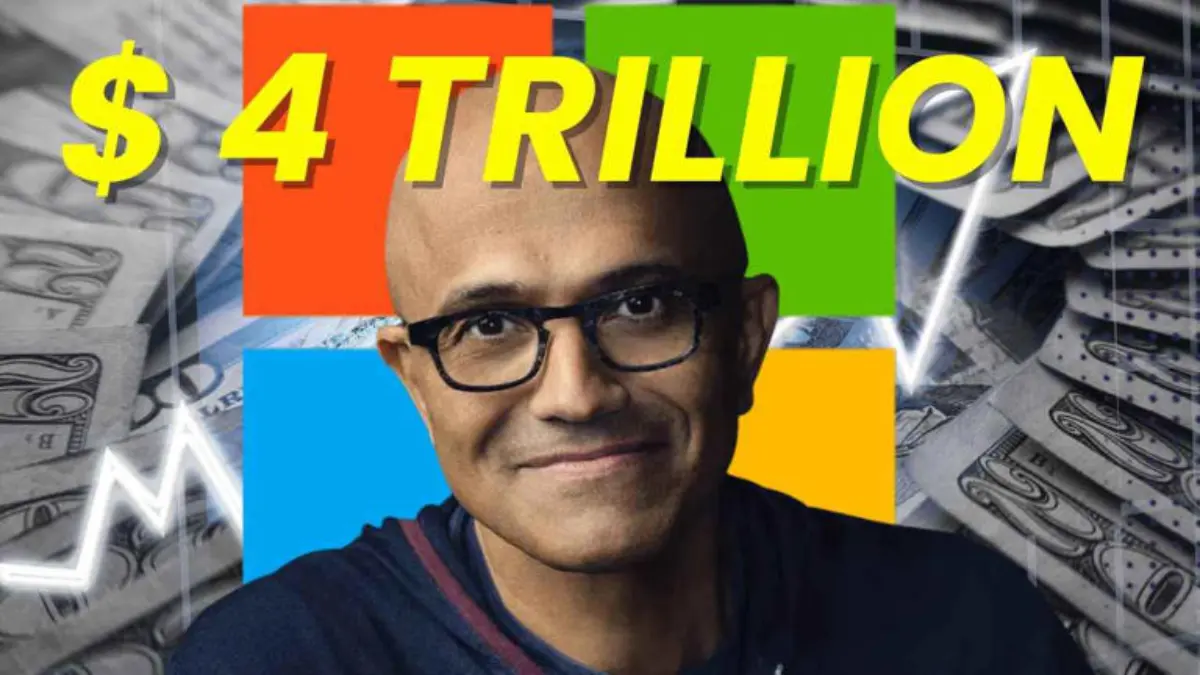Microsoft has become the second company ever to hit a $4 trillion valuation, fueled by booming AI adoption, Azure cloud growth, and record capital investments. Here’s how Satya Nadella’s strategy is shaping the tech future.
Table of Contents
Microsoft Has Become the Next $4 Trillion Company
🚀 The Big Milestone
Microsoft just joined one of the most exclusive clubs in global business — the $4 trillion market valuation club — and it didn’t get there by accident. The tech titan’s shares surged nearly 4.5% on Thursday, hitting an intraday valuation of $4.01 trillion, just hours after a blockbuster earnings report.
For context:
- Microsoft reached $1T in April 2019.
- It hit $3T just 18 months ago.
- And now, $4T — a feat only Nvidia had reached before this month.
While valuations of this scale are eye-popping on their own, the way Microsoft got here is a masterclass in strategic timing, AI dominance, and operational discipline.
📈 The Market’s Reaction — And Why It’s Bigger Than Just One Day
Microsoft’s stock has climbed 28% year-to-date, outpacing the broader S&P 500 and even tech-heavy Nasdaq gains. Thursday’s jump wasn’t just enthusiasm — it was Wall Street validating years of positioning.
Several forces converged:
- Earnings Beat – Azure’s cloud revenue growth beat analyst expectations.
- AI-Driven Productivity – Microsoft 365’s “Copilot” AI integration is gaining real adoption.
- Macro Tailwinds – Breakthroughs in US trade talks have buoyed investor sentiment.
This wasn’t a meme-stock style spike. This was institutional investors doubling down on Microsoft as the AI backbone of enterprise computing.
🧠 AI as Microsoft’s Growth Engine
The OpenAI partnership is proving to be the most transformative corporate alliance of the decade. With exclusive access to OpenAI’s GPT models, Microsoft has integrated generative AI into:
- Azure Cloud — now the company’s top revenue driver, attracting enterprises looking for AI-ready infrastructure.
- Microsoft 365 — Copilot AI is being bundled directly into Office, transforming Word, Excel, Outlook, and Teams.
- GitHub Copilot — changing how developers write and ship code.
Satya Nadella recently revealed that 20–30% of Microsoft’s code is now AI-generated. This is more than a novelty — it’s a cost-reduction strategy, a speed-to-market advantage, and a stickiness driver for customers.
⚖️ Comparing to the Competition
- Nvidia (NVDA): Reached $4T first by dominating AI chip production.
- Apple (AAPL): Still valued at $3.12T, battling hardware saturation.
- Google (GOOGL): Facing slower AI monetization despite huge research.
- Amazon (AMZN): AWS remains strong, but Microsoft’s AI narrative is stealing headlines.
The difference? Microsoft is both selling AI tools and using AI internally at scale — creating a flywheel effect.
🌍 The Geopolitical Backdrop
While Trump’s tariff offensive has rattled many global players, Microsoft has largely sidestepped direct financial pain. With AI demand so strong, enterprise clients are prioritizing Microsoft’s tools even in uncertain markets.
This resilience is in stark contrast to other sectors where tariffs have choked demand.
🔧 Operational Discipline: Layoffs & Efficiency
Despite meteoric growth, Microsoft has been tightening its workforce:
- July 2025: Cut 9,000 employees (~4% of staff).
- May 2025: Cut 6,000 employees.
While these are tough moves, Microsoft frames them as productivity-driven restructuring, enabled by AI making employees more efficient.
In other words, the company is eating its own cooking — deploying AI to improve its own operations.
📊 Why Investors Are Confident
Microsoft has delivered back-to-back record revenues since late 2022, powered by:
- Cloud dominance.
- Enterprise AI adoption.
- Aggressive capital investments (forecast: $30B this quarter alone).
With generative AI still in its early monetization phase, Wall Street sees Microsoft’s AI moat widening, not shrinking.
⚠️ Risks to Watch
- Regulatory scrutiny — Exclusive OpenAI access could invite antitrust pressure.
- AI adoption curves — Enterprises could take longer to deploy AI tools broadly.
- Competitive chip ecosystems — Dependence on Nvidia GPUs leaves exposure to supply issues.
Still, with diversified revenue streams, Microsoft is better insulated than most.
🔮 The Road to $5 Trillion?
If AI monetization scales faster than expected, $5T isn’t far off. But it will require:
- Continued Azure growth.
- Broad Copilot adoption across industries.
- Smooth navigation of political and regulatory landmines.
Microsoft’s strategy so far suggests it’s willing to make bold bets early, and that’s exactly what the AI era rewards.
📢 Final Take
Microsoft’s $4 trillion milestone isn’t just about stock charts — it’s a signal that the AI-driven tech economy is here. By pairing smart acquisitions, internal AI integration, and aggressive cloud expansion, the company has become the picks-and-shovels provider for the AI gold rush.
The next valuation milestone might come sooner than anyone expects. And if history is any guide, Microsoft will be ready for it.
